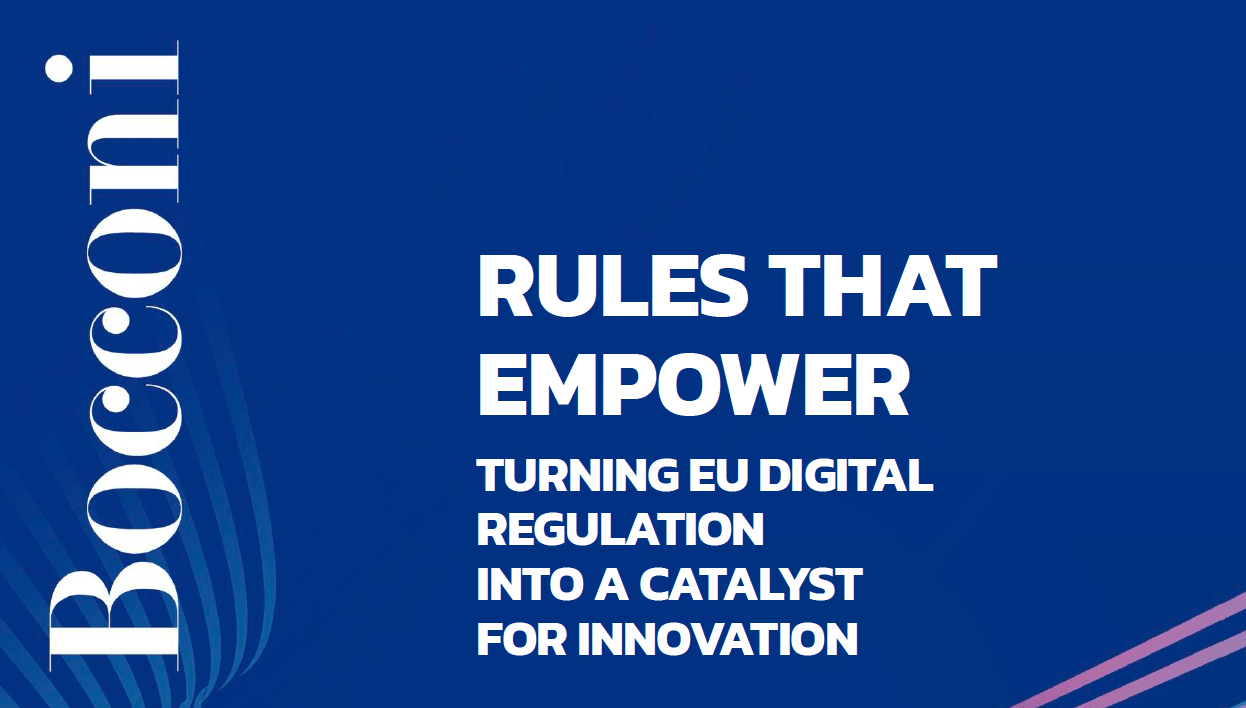IEP@BU Report - Rules That Empower
This report focuses on how the EU can manage global trends in the digital ecosphere, with a particular emphasis on the rules that it has set to govern relationships between platforms and businesses

Extended Abstract
The digital landscape of Europe is currently undergoing significant technological and regulatory transformations. The primary challenges for the European Union lie in promoting an EU-based tech sector while managing major global trends such as the influence of dominant platforms, the rapid development of artificial intelligence, the advent of decentralized business networks, and the spread of dual-use technologies.
Regarding the first objective – promoting innovation – a recent report (EU Innovation Policy - How to Escape the Middle Technology Trap) by researchers at CESifo EconPol Europe, the Institute for European Policymaking at Bocconi University and the Toulouse School of Economics has focused on the financing of Research and Development (R&D).
It highlighted critical elements including fragmented funding at the Member State level, funding toward traditional sectors (like automotive) rather than native-digital sectors, and governance weaknesses in the European Innovation Council compared to the US ARPAs (Advanced Research Project Agencies).
Overall, that report argues that current European efforts are not sufficient, in both quantity and quality, to enable Europe to compete in the value-creating space of the digital economy.
This report focuses on the second objective: how the EU can manage global trends in the digital ecosphere, with a particular emphasis on the rules that it has set to govern relationships between platforms and businesses.
European institutions have dedicated substantial attention to this relationship, adopting a regulatory approach so intense that the term “Brussels effect” has emerged to describe how EU regulations impact big tech companies globally, as these companies adapt to these rules even outside the Union’s borders. For example, in areas like data protection and privacy, the enactment of the landmark GDPR led companies such as Meta to implement (some aspects of) GDPR globally.
However, while GDPR has notable merits, according to most recent studies it has also hurt innovation and growth, underscoring the need to carefully balance innovation and regulation.
While critics often argue that regulations impede growth and investment, numerous examples show that well-crafted rules can instead foster both. In the renewable energy sector, EU directives and incentives such as feed-in tariffs spurred large-scale investments in solar and wind technologies, making Europe a global leader in clean energy. In the automotive industry, strict safety regulations mandating features like airbags and anti-lock braking systems drove innovation and investment in safer vehicle technologies, enhancing both consumer trust and market competitiveness.
Similarly, post-crisis financial reforms like Basel III strengthened the stability of the banking sector, reducing risks and attracting long-term investment. The pharmaceutical sector, despite its heavy regulatory oversight, continues to draw significant capital due to the certainty and credibility provided by rigorous drug approval processes.
However, not all regulatory frameworks have been as successful. For example, in telecommunications, market liberalization has sometimes struggled to reconcile competition with sustained investment in infrastructure. Similarly, GDPR, while enhancing consumer trust, has created compliance challenges, especially for smaller firms.
These examples highlight that regulatory frameworks must provide clarity, predictability, and proportional enforcement to support both investment and innovation over the long term.
This report analyzes the wave of new tech regulations in Europe and their effects to suggest a series of refinements needed to make them effective in promoting an EU-based tech sector.
Over the last few years, the European Union has undertaken a regulatory revolution with major legislative acts, including the Digital Markets Act (DMA), the Digital Services Act (DSA), and the Artificial Intelligence Act (AIA). These regulations have important implications for internet users, businesses, and platforms.
Although the regulatory implications for users are relevant for the interaction between EU citizens and platforms – particularly in the case of DSA – this report will focus on the economic relevance of new tech regulations, therefore investigating the impact on business-to-platform relationships. In this area, we see the need to avoid creating uncertainty in the rules or increasing the red tape; the need is not for new rules or dramatic deregulation, but rather for smart enforcement of the current rules and their careful refinement.
This approach would best serve EU businesses.
The DMA is a notable example of balance between innovation and regulation, and of a differentiated approach toward large platforms and other tech players: the obligations of the DMA are primarily designed to limit the power of the largest tech platforms (i.e., gatekeepers), while fostering competition, contestability, and the entry of new and smaller business operators to the core platform services in Europe. The landmark decision in 2022 to regulate the interaction between large platforms and the businesses operating with them signals a new era of regulation for the technology sector and has far-reaching implications for the designated companies and the broader digital sector.
However, achieving a balance between the different objectives is complex, particularly as the technologies the EU aims to regulate are central to the new economic and geopolitical competition. Will this new regulatory approach prove adequate in curbing the abuse of major platforms? Will it achieve the goal of making digital markets fairer and more accessible? How can the current regulatory approach be improved to achieve market competition and contribute to enhance the EU digital sector?
In this report, researchers at the Institute for European Policymaking at Bocconi University and the Toulouse School of Economics investigate these key questions. It aims to provide an in-depth analysis of the challenges posed by the digital economy and the regulatory approaches required to address them. It also underscores the importance of EU legislation in preventing the extreme concentration of digital markets and curbing the disproportionate power wielded by major technology companies.
This report analyzes critical issues within the digital economy and proposes several policy recommendations for improvement. Chapter 1 establishes the importance of addressing these issues, while Chapters 2 through 4 offer concrete and actionable policy proposals directly derived from the analyses presented within each chapter, providing practical pathways to address the challenges discussed.
In particular, Chapters 2 and 3 offer distinct policy recommendations for mitigating market concentration, while Chapter 4 outlines key recommendations for implementing an alternative, decentralized model. Grounded in state-of-the-art economic, legal and managerial research, the report focuses on refining existing regulations rather than proposing extensive modifications.
In begins in the first chapter from presenting constitutionalism as a principle for understanding the societal need to having rules that adequately balance big tech’s influence with public oversight.
Traditional competition and antitrust tools struggle to counter the power of major digital actors. The introduction of the DMA was meant to overcome this limitation, but it raises new questions about the interplay between regulatory, constitutional, and antitrust law. This regulation shifts focus from economic aspects of digital platforms to addressing how these powerful entities interact with public power. While classical constitutionalism limited government authority via principles like separation of powers, today’s “digital constitutionalism” must address the shift in power dynamics from vertical (public power vs. individuals) to horizontal or diagonal (private powers vs. individuals).
The second chapter explores the relationship between the DMA and EU antitrust law, framing the DMA’s role within the competition policy approach pursued by the Commission through recent antitrust interventions in digital markets.
It also examines specific insights from DMA rules and their application to platform services such as digital advertising, marketplaces, internet search and social networks.
The chapter’s policy proposals aim to refine and enhance the DMA provisions as practical tools for fostering a more prosperous digital economy in Europe. Without proposing radical changes, it emphasizes how and why strengthening the DMA rules ensuring that platforms’ business partners interact in a stable and fair context that can be conducive to their growth and investments.
The third chapter addresses merger control, a key competition law tool. Concentration projects involving digital players have shaped big tech’s external growth and spurred policy debates. Concerns over under-enforcement have led to calls for stronger interventions at both the Commission and Member State levels, but this runs against a recent political proposal by the newly formed Commission. Through a comparative analysis of economic research on digital mergers’ impact on innovation and recent enforcement experiences in the EU and US, this chapter offers an understanding of these opposite viewpoints and novel policy suggestions to improve the ability of enforcers to address the most problematic effects of digital mergers.
The fourth chapter explores the potential of Web 3.0 platforms to decentralize internet access. These platforms represent new models of distributed governance and credible alternatives to the centralized Web 2.0 model dominated by a few large platforms. Web 3.0 leverages Distributed Ledger Technologies (DLTs), blockchain, Decentralized Finance (DeFi), and Decentralized Autonomous Organizations (DAOs). The chapter discusses various practical examples of Web 3.0 and proposals for B2B supply-chain finance solutions that reduce fragmentation and ensure interoperability, thereby enhancing internal capital markets and supply-chain finance efficiency.
Overall, the recommendation in this report can be seen as the proposal of a paradigm shift aimed at redistributing power from big tech companies to individual users and smaller entities that seek to grow and invest to achieve an adequate scale to compete globally in today’s digital markets dominated by large platforms. It is a particularly appealing development for European institutions aiming to foster competition and innovation within the single market.
The report provides several policy proposals for facilitating the adoption of this new paradigm.
The regulatory interventions in the European digital sector analyzed in this study are fundamental, but the web of relevant rules is broader and more complex than what we discuss.
A complete picture would need to include, for instance, the regulations governing investments such as the supervision of State aid to various large-scale, cross-country investments (such as the IPCEI, Important Projects of Common European Instruments) and, more broadly, the revision of State aid rules to enhance the capability of public financing of the digital transition.
Moreover, on the rules governing data, the EU is currently exploring new, better venues relative to the GDPR to strike a balance between innovation and regulation by intervening in data markets.
The recent data regulation is a notable example as it aims to expand safe access to public and private data, ideally enabling new businesses to thrive. Although not the focus of this report, the following chapters will delve into the role of data in several specific instances, such as in the digital advertising market (Chapter 2) and in merger regulation (Chapter 3).
Finally, it should be stressed that any recommendation for the evolution of the regulation of the digital sector needs to coordinate with the evolution of AI.
Since this aspect is so broad and relevant by itself, it will not be addressed in this report, but it will be at the heart of a forthcoming report complementing the current one.
Authors
Francesco Decarolis, Giovanni De Gregorio, Chiara Fumagalli, Yassine Lefouili, Bruno Jullien, Mariateresa Maggiolino, Oreste Pollicino, Michele Polo, Claudio Tebaldi
Report Coordinator
Fancesco Decarolis
IEP@BU does not express opinions of its own. The opinions expressed in this publication are those of the authors. Any errors or omissions are the responsibility of the authors.




